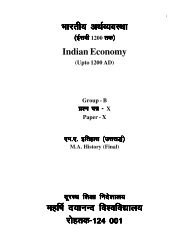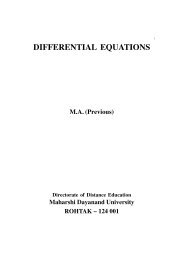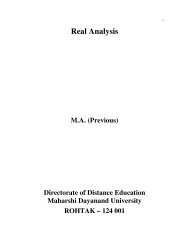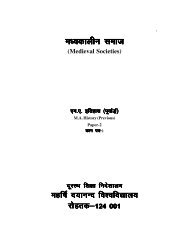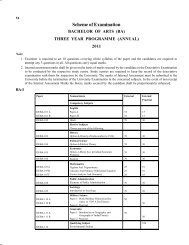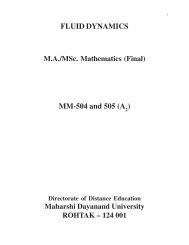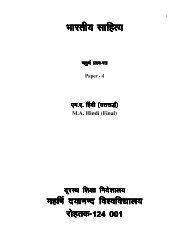LITERATURE AND GENDER - Maharshi Dayanand University, Rohtak
LITERATURE AND GENDER - Maharshi Dayanand University, Rohtak
LITERATURE AND GENDER - Maharshi Dayanand University, Rohtak
Create successful ePaper yourself
Turn your PDF publications into a flip-book with our unique Google optimized e-Paper software.
Tennessee Williams: A Street Car Named Desiredone by the artist with personal indulgence, made either a model or a monster. In any case, the portrait would sufferfrom an exaggeration in the positive or negative direction depending on warm or cold equation of the writer with thehistorical person in hand.In the case of Williams’s A Streetcar Named Desire, the portrait of Stanley may have received a grain of prejudicethe dramatist had come to develop against his father, though not without a sound basis. But Williams is free from thesentimentality of Dickins, hence the exaggerations are less because of personal reasons and more because of theartistic. Even less prejudiced than the portrait of Stanley is that of Stella, and understandably so because Williamsenjoyed a positive and warm equation with his mother on whom the character of Stella seems to be based, if notentirely, at least partly. Even the portrait of Blanche is not without a basis in real life. The dramatist’s own sister Rose,whose mental breakdown in later life was caused by the harsh treatment of their father, too, seems to have provideda model for Blanche. Like the metaphor or simile, of course, the comparison between subject and object, or tenor andvehicle, is never in every detail about the two personalities. It is more in the nature of a vague sort of similarity whichone perceives without much precision. What Aristotle calls recognition of the familiar is what provides pleasure inliterature. Thus, we see these similarities only to seek greater clarification and clarify as to the nature of characterson the stage or in the pages of a work, not at all for knowing about the biographical details of the author.A Streetcar Named Desire, though having some basis in the personal life of the dramatist, stands on its ownas a work of art, speaking for life far beyond the limits of an individual experience. Here, in the play, theindividual or personal experience acquires a universal character, making characters, as well as incidents,types of general human nature. And it is this aspect of the story that makes it art, not the aspect of its beingclose to the writer’s own life. Williams’s strength as artist lies in transforming the personal into impersonal,the subjective into objective. And it is for this very quality of objectivity that Williams is valued as adramatist and artist. The personal source of the play’s plot or a part of the plot has been its strength,carrying a certain resonance not possible otherwise, and not carrying an untransformed personal elementin any portrait. No wonder that the play has been popular for its objectivity and authenticity, and not forany personal or sentimental reasons.BOOKS FOR FURTHER READING1. BANTLEY, ERIC, The Dramatic Event (New York, 1954)2. …………………., In Search of Theatre (New York, 1953).3. CORRIGAN, ROBERT (ed.), Theatre in the twentieth Century (New York, 1963).4. GASSNER, JOHN, Direction in Modern Theatre and Drama (New York, 1963).5. TAUBMAN, HOWARD, The Making of the American Theatre (New York, 1962).6. WEALES, GERALD, American Drama Since World War II (New York, 1962).7. DONAHUE, FRANCIS, The Dramatic World of Tennessee Williams (New York, 1964).8. FALK, SIGNI, Tennessee Williams (New York, 1962).9. NELSON, BENJAMIN, Tennessee Williams: The Man and His Work (New York, 1961).10. TISCHLER, NANCY, Tennessee Williams, Rebellious Puritan (New York, 1961).QUESTION BANK1. Consider A Streetcar Named Desire as a play about gender conflict.2. Discuss A Streetcar Named Desire from the viewpoint of feminist critical theory.3. Compare and contrast the characters of Blanche and Stella in A Streetcar Named Desire.4. Write a note on the role and significance of minor female characters in A Streetcar Named Desire.5. Interpret A Streetcar Named Desire from the viewpoint of women as ‘other.’6. Interpret A Streetcar Named Desire from the viewpoint of Stanley and his friends as the ‘other.’7. Discuss A Streetcar Named Desire as the tragedy of a modern woman.8. Write a note on the plot structure of A Streetcar Named Desire.9. Discuss Williams’s use of ‘expressionism’ in A Streetcar Named Desire.10. Write a note on the function and significance of audio-visual aids in A Streetcar Named Desire.35



